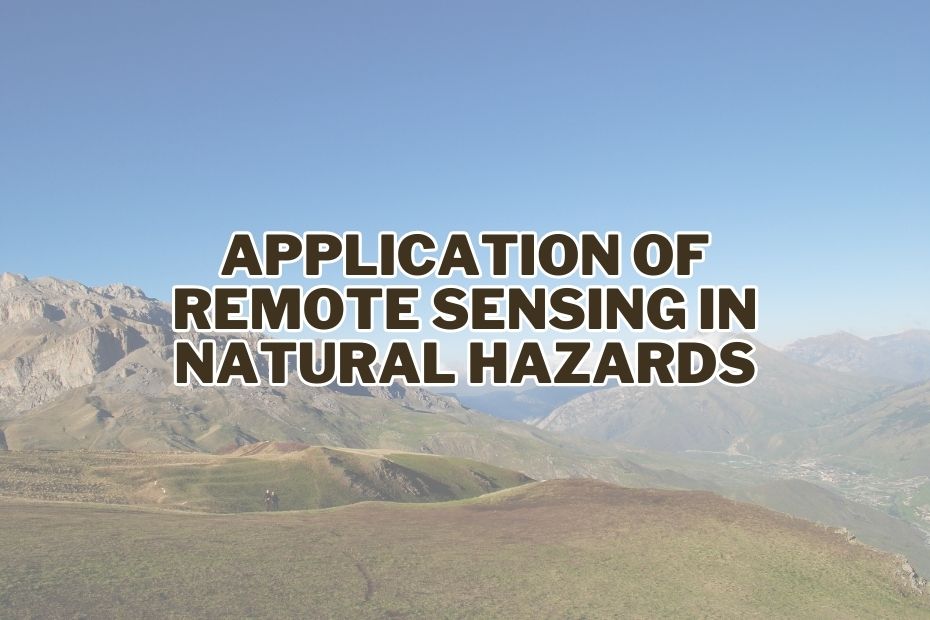Natural hazards pose significant threats to both human lives and the environment. With the advent of advanced technology, remote sensing has emerged as a powerful tool for monitoring and managing these hazards. In this article, we delve into the multifaceted application of remote sensing in natural hazards.
Remote sensing plays a pivotal role in monitoring and managing natural hazards. By capturing data from satellites or aircraft, it aids in the early detection, assessment, and prediction of disasters like floods, earthquakes, and forest fires.
Why is Remote Sensing Essential for Natural Hazards?
Remote sensing acts as a pivotal tool in anticipating and responding to natural hazards, serving as our vigilant eyes in the sky. It provides early warning capabilities, detecting signs of impending disasters like cyclones or tectonic anomalies that could lead to earthquakes.
This timely detection is invaluable for preparedness, evacuation, and safeguarding communities. Post-disaster, remote sensing aids in assessing the extent of damage, facilitating efficient recovery strategies.
By continuously monitoring vast terrains and collecting real-time data, it offers a cost-effective, safe, and comprehensive approach to understanding and mitigating the impact of natural calamities.
Application of Remote Sensing In Natural Hazards
The advancement of remote sensing technology has revolutionized our understanding and management of natural hazards. As these calamities increase in frequency due to climate change, we leverage the precision of remote sensing for timely detection, monitoring, and response.
1. Earthquake Monitoring
Earthquakes are sudden geological events that can cause widespread devastation. Remote sensing plays a vital role in earthquake monitoring by providing real-time data on ground displacement, fault movements, and tectonic activities. Satellite-based Synthetic Aperture Radar (SAR) helps detect ground shifts, aiding in early warning systems and disaster response.
2. Flood Detection and Management
Floods are among the most common and destructive natural disasters. Remote sensing aids in flood detection by monitoring changes in water levels and identifying vulnerable areas. This information assists in emergency response and urban planning to mitigate flood impacts effectively.
3. Volcano Surveillance
Volcanic eruptions can have catastrophic consequences. Remote sensing techniques such as thermal imaging and gas monitoring help scientists track volcanic activities. This data is crucial for predicting eruptions and managing potential hazards.
4. Tsunami Warnings
Remote sensing contributes to tsunami warning systems by monitoring the ocean’s surface using altimeters and buoys. This technology helps in predicting the magnitude and arrival time of tsunamis, enabling coastal communities to evacuate in a timely manner.
5. Landslide Identification
Landslides can be triggered by heavy rainfall, earthquakes, or volcanic activities. Remote sensing aids in identifying landslide-prone areas through terrain analysis and monitoring ground deformation, allowing for risk assessment and preventive measures.
6. Coastal Erosion Surveillance
Coastal erosion poses a threat to shorelines and infrastructure. Remote sensing techniques like LiDAR (Light Detection and Ranging) provide accurate topographical data, aiding in coastal erosion monitoring and management.
7. Drought Monitoring
Droughts have far-reaching socio-economic impacts. Remote sensing helps monitor vegetation health, soil moisture, and water availability, providing critical information for drought prediction and water resource management.
8. Wildfire Tracking
Wildfires can spread rapidly and wreak havoc on ecosystems. Remote sensing aids in tracking fire progression, identifying fire hotspots, and assessing burn severity. This information guides firefighting efforts and ecosystem recovery.
9. Desertification Monitoring
Desertification, driven by factors like climate change and human activities, threatens arable land. Remote sensing assists in tracking vegetation degradation and land cover changes, facilitating early intervention to prevent desertification.
10. Cyclone and Hurricane Forecasting
Cyclones and hurricanes pose significant risks to coastal regions. Remote sensing provides essential data on storm movement, intensity, and wind patterns, enabling accurate forecasting and preparedness.
11. Glacier Melt Analysis
Glacier melt contributes to rising sea levels. Remote sensing technology, including satellite imagery and altimetry, enables the monitoring of glacier mass loss and ice volume changes, aiding in climate research.
12. Soil Erosion Monitoring
Soil erosion depletes fertile land and affects agricultural productivity. Remote sensing helps assess soil erosion rates, identify vulnerable areas, and support soil conservation efforts.
13. Tornado Surveillance
Tornadoes are violent windstorms that can cause widespread destruction. Remote sensing, particularly Doppler radar and satellite imagery, assists in detecting tornado formation and tracking their paths.
14. Sea Ice Movement
Sea ice plays a vital role in Earth’s climate system. Remote sensing techniques help monitor sea ice extent, thickness, and movement, contributing to our understanding of polar regions and climate change.
15. Coral Reef Health Assessment
Coral reefs are delicate ecosystems facing threats from pollution and climate change. Remote sensing allows researchers to assess coral reef health, detect bleaching events, and support conservation efforts.
16. Radiation Leak Detection
In the event of a nuclear incident, remote sensing can monitor radiation levels and aid in assessing the extent of contamination. This information is crucial for public safety and disaster response.
17. Groundwater Exploration
Remote sensing assists in mapping groundwater resources by analyzing land surface characteristics and subsurface structures. This technology helps in sustainable water management and addressing water scarcity.
Conclusion:
In conclusion, the application of remote sensing in natural hazards provides invaluable insights that enhance disaster preparedness, response, and mitigation strategies. From earthquake monitoring to groundwater exploration, the integration of technology with scientific expertise is shaping a safer and more resilient world.
FAQs: Application of Remote Sensing In Natural Hazards
How does remote sensing predict natural hazards?
By capturing data and analyzing patterns, anomalies, or changes in the Earth’s surface and atmosphere.
Can remote sensing predict every natural disaster?
While it can monitor and provide early warnings for many disasters, it may not predict every unforeseen event.
How do authorities use remote sensing data?
They use the data to issue warnings, plan evacuations, assess damages, and formulate response strategies.
How does remote sensing contribute to earthquake monitoring?
Remote sensing, particularly Synthetic Aperture Radar (SAR), detects ground displacement and tectonic activities, aiding in early earthquake warnings.
